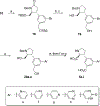Stereoselective Synthesis of New (2 S,3 R)-3-Carboxyphenyl)pyrrolidine-2-carboxylic Acid Analogues Utilizing a C(sp3)-H Activation Strategy and Structure-Activity Relationship Studies at the Ionotropic Glutamate Receptors
- PMID: 32065744
- PMCID: PMC7227796
- DOI: 10.1021/acschemneuro.0c00003
Stereoselective Synthesis of New (2 S,3 R)-3-Carboxyphenyl)pyrrolidine-2-carboxylic Acid Analogues Utilizing a C(sp3)-H Activation Strategy and Structure-Activity Relationship Studies at the Ionotropic Glutamate Receptors
Abstract
Competitive antagonists for ionotropic glutamate receptors (iGluRs) are highly valuable tool compounds for studying health and disease states in the central nervous system. However, only few subtype selective tool compounds are available and the discovery of antagonists with novel iGluR subtype selectivity profiles remains a profound challenge. In this paper, we report an elaborate structure-activity relationship (SAR) study of the parental scaffold 2,3-trans-3-carboxy-3-phenyl-proline by the synthesis of 40 new analogues. Three synthetic strategies were employed with two new strategies of which one being a highly efficient and fully enantioselective strategy based on C(sp3)-H activation methodology. The SAR study led to the conclusion that selectivity for the NMDA receptors was a general trend when adding substituents in the 5'-position. Selective NMDA receptor antagonists were obtained with high potency (IC50 values as low as 200 nM) and 3-34-fold preference for GluN1/GluN2A over GluN1/GluN2B-D NMDA receptors.
Keywords: C(sp3)−H activation; Electrophysiology; Ionotropic glutamate receptors; NMDA receptor antagonist; Proline analogues.
Figures



















Similar articles
-
Design and Synthesis of 2,3- trans-Proline Analogues as Ligands for Ionotropic Glutamate Receptors and Excitatory Amino Acid Transporters.ACS Chem Neurosci. 2019 Jun 19;10(6):2989-3007. doi: 10.1021/acschemneuro.9b00205. Epub 2019 May 24. ACS Chem Neurosci. 2019. PMID: 31124660 Free PMC article.
-
Design and Synthesis of a Series of l-trans-4-Substituted Prolines as Selective Antagonists for the Ionotropic Glutamate Receptors Including Functional and X-ray Crystallographic Studies of New Subtype Selective Kainic Acid Receptor Subtype 1 (GluK1) Antagonist (2S,4R)-4-(2-Carboxyphenoxy)pyrrolidine-2-carboxylic Acid.J Med Chem. 2017 Jan 12;60(1):441-457. doi: 10.1021/acs.jmedchem.6b01516. Epub 2016 Dec 22. J Med Chem. 2017. PMID: 28005385
-
Structure-Activity Relationship Study of Ionotropic Glutamate Receptor Antagonist (2S,3R)-3-(3-Carboxyphenyl)pyrrolidine-2-carboxylic Acid.J Med Chem. 2015 Aug 13;58(15):6131-50. doi: 10.1021/acs.jmedchem.5b00750. Epub 2015 Jul 22. J Med Chem. 2015. PMID: 26200741
-
A comprehensive description of GluN2B-selective N-methyl-D-aspartate (NMDA) receptor antagonists.Eur J Med Chem. 2020 Aug 15;200:112447. doi: 10.1016/j.ejmech.2020.112447. Epub 2020 May 16. Eur J Med Chem. 2020. PMID: 32450321 Review.
-
Emerging structural insights into the function of ionotropic glutamate receptors.Trends Biochem Sci. 2015 Jun;40(6):328-37. doi: 10.1016/j.tibs.2015.04.002. Epub 2015 May 1. Trends Biochem Sci. 2015. PMID: 25941168 Free PMC article. Review.
Cited by
-
Structure, Function, and Pharmacology of Glutamate Receptor Ion Channels.Pharmacol Rev. 2021 Oct;73(4):298-487. doi: 10.1124/pharmrev.120.000131. Pharmacol Rev. 2021. PMID: 34753794 Free PMC article. Review.
-
Serum metabolomic analysis reveals key metabolites in drug treatment of central precocious puberty in female children.Front Mol Neurosci. 2023 Jan 27;15:972297. doi: 10.3389/fnmol.2022.972297. eCollection 2022. Front Mol Neurosci. 2023. PMID: 36776772 Free PMC article.
References
-
- Meldrum BS Glutamate as a Neurotransmitter in the Brain: Review of Physiology and Pathology. J. Nutr 2000, 130 (4), 1007S–1015S. - PubMed
-
- Riaza Bermudo-Soriano C; Perez-Rodriguez MM; Vaquero-Lorenzo C; Baca-Garcia E New Perspectives in Glutamate and Anxiety. Pharmacol. Biochem. Behav 2012, 100 (4), 752–774. - PubMed
-
- McCarthy DJ; Alexander R; Smith MA; Pathak S; Kanes S; Lee CM; Sanacora G Glutamate-Based Depression GBD. Med. Hypotheses 2012, 78 (5), 675–681. - PubMed
Publication types
MeSH terms
Substances
Grants and funding
LinkOut - more resources
Full Text Sources
Miscellaneous

